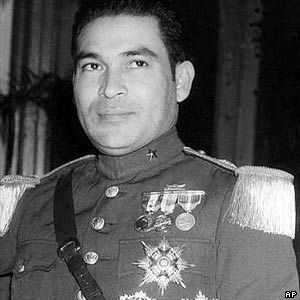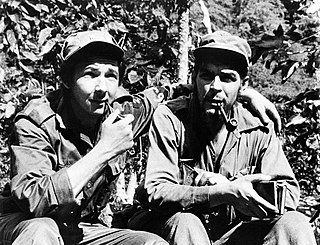 W
WThe Republic of Cuba from 1902 to 1959 encompasses the period after Cuba's independence from the Spanish Empire and end of its first U.S. military occupation in 1902. This era included various changing governments and US military occupations, and ended with the success of the Cuban Revolution in 1959. During this period, the United States exerted great influence on Cuban politics, notably through the Platt Amendment.
 W
WThe 1952 Cuban coup d'état took place in Cuba on March 10, 1952, when the Cuban Army, led by Fulgencio Batista, intervened in the election that was scheduled to be held on June 1, staging a coup d'état and establishing a de facto military dictatorship in the country.
 W
WThe Battle of the Hotel Nacional de Cuba took place from October 2–3, 1933. After the Sergeants' Revolt on September 3, 1933 and the proclamation of Fulgencio Batista as the new Army Chief of Staff, replacing Julio Sanguily Echarte, the higher ranking army officials refused to recognize this proclamation. Suffering from a hemorrhaging ulcer in his stomach at the time, Sanguily would rest at the Hotel Nacional de Cuba. In addition to Sanguily, the United States ambassador, Sumner Welles was also staying at the Hotel Nacional de Cuba. Given the importance of Sanguily, who in the eyes of the higher ranking army officials, was the legitimate Army Chief of Staff and on the other hand the fact that the U.S. ambassador himself was staying at Hotel Nacional, it followed that the Hotel Nacional was the perfect place for the army officials to regroup and put Ramon Grau's government in a deadlock.
 W
WThe Cuban Revolution was an armed revolt conducted by Fidel Castro's revolutionary 26th of July Movement and its allies against the military dictatorship of Cuban President Fulgencio Batista. The revolution began in July 1953, and continued sporadically until the rebels finally ousted Batista on 31 December 1958, replacing his government. 26 July 1953 is celebrated in Cuba as the Day of the Revolution . The 26th of July Movement later reformed along Marxist-Leninist lines, becoming the Communist Party of Cuba in October 1965.
 W
WThe One Hundred Days Government is the name normally used in Cuba to refer to the Cuban government of Ramon Grau which lasted from September 4, 1933 until January 15, 1934.
 W
WPentarchy of 1933, formally known as the Executive Commission of the Provisional Government of Cuba, was a coalition that ruled Cuba from September 5 to September 10, 1933 after Gerardo Machado was deposed on August 12, 1933. Prior to the Pentarchy, General Alberto Herrera and Carlos Manuel de Céspedes y Quesada served as President of Cuba.
 W
WOn March 2, 1901, the Platt Amendment was passed as part of the 1901 Army Appropriations Bill. It stipulated seven conditions for the withdrawal of United States troops remaining in Cuba at the end of the Spanish–American War, and an eighth condition that Cuba sign a treaty accepting these seven conditions. It defined the terms of Cuban–U.S. relations essentially to be an unequal one of U.S. dominance over Cuba.
 W
WThe Sergeants' Revolt, also called the Cuban Revolution of 1933, was a coup d'etat that occurred in Cuba in September 1933. It began as a revolt of sergeants and enlisted men in the military, who soon allied with student activists in the Directorio Estudiantil Universitario.
 W
WThe history of Cuba during World War II begins in 1939. Because of Cuba's geographical position at the entrance of the Gulf of Mexico, Havana's role as the principal trading port in the West Indies, and the country's natural resources, Cuba was an important participant in the American Theater of World War II, and it was one of the greatest beneficiaries of the United States' Lend-Lease program. Cuba declared war on the Axis powers in December 1941, making it one of the first Latin American countries to enter the conflict. When the war ended in 1945, the Cuban military had developed a reputation of being the most efficient and co-operative Caribbean nation.